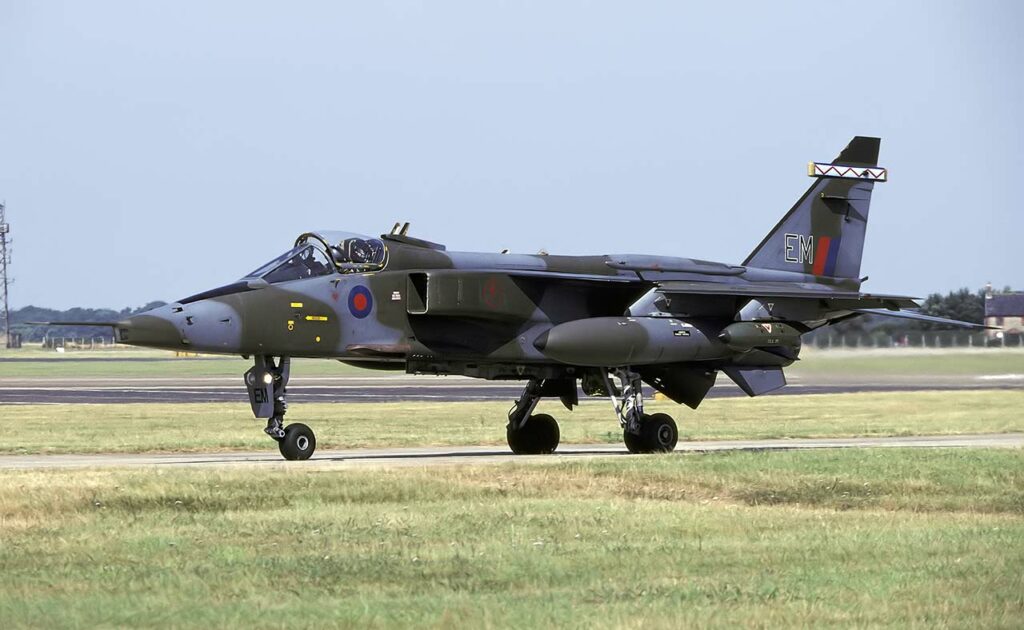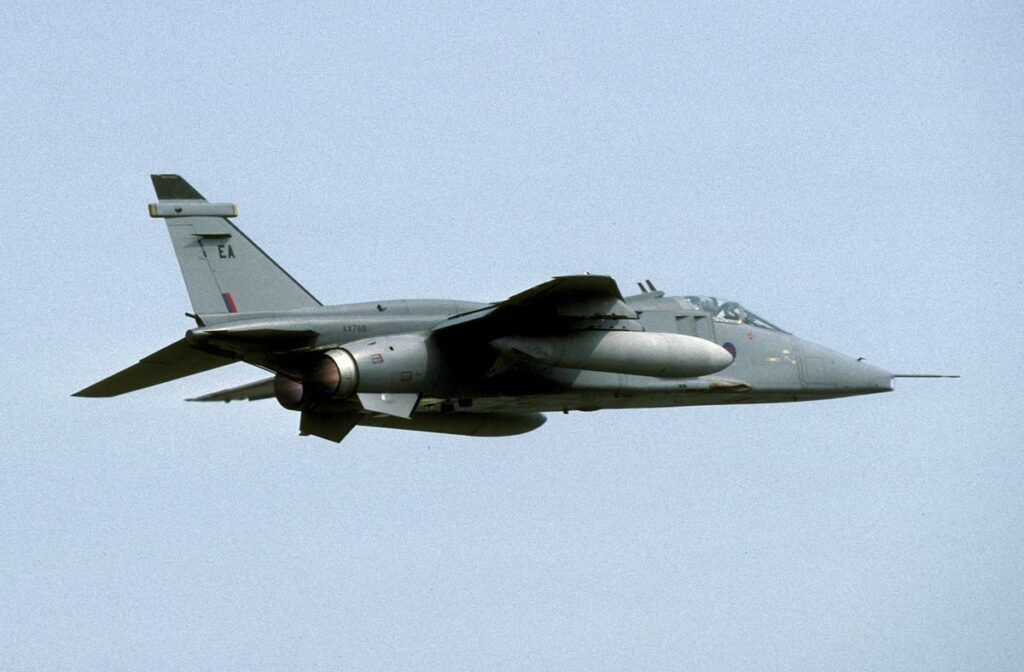Anglo-French tactical attack aircraft, dual-engine, with fixed-wing, known for low-altitude, high-speed capabilities.
In brief
The Sepecat Jaguar, an Anglo-French jet designed in the 1960s, excels in close air support, nuclear strike, and tactical reconnaissance roles. This aircraft is powered by two Rolls-Royce Turbomeca Adour turbofan engines, facilitating speeds of up to Mach 1.1. Its structure is built for low-level, high-speed flight, featuring a high-wing loading and a strong, durable frame to withstand the rigors of low-altitude flight. The Jaguar is equipped with an advanced navigation and attack system, allowing for precise targeting in diverse weather conditions. Its operational flexibility is enhanced by a substantial payload capacity, capable of deploying a variety of weapons systems. The aircraft’s design emphasizes simplicity and efficiency, contributing to its extensive service life and adaptability to various upgrade programs.

The Sepecat Jaguar fighter jet
The inception of the Sepecat Jaguar traces back to the early 1960s, amidst the Cold War’s height, where the need for a versatile, robust, and efficient tactical support aircraft became evident within the NATO alliance. The aircraft was a product of Anglo-French cooperation, aimed at fulfilling both the Royal Air Force’s and French Air Force’s requirements for an advanced training and light attack aircraft. The program was officially launched in 1965, under the management of the newly formed Sepecat consortium, a collaboration between Breguet Aviation of France and the British Aircraft Corporation.
The Jaguar first took to the skies on 8 September 1968, showcasing its potential as a multi-role combat aircraft. Its development was driven by the strategic necessity for a platform capable of delivering both conventional and nuclear payloads, conducting reconnaissance missions, and offering tactical air support. The aircraft did not receive a specific NATO nickname, as it was primarily operated by France and the UK, though its versatility and performance made it a valued asset within both air forces.
Design
The Sepecat Jaguar’s design is a testament to the blend of British and French aviation technology. Measuring 55 feet in length with a wingspan of 28 feet, and standing 15 feet tall (16.8 m x 8.69 m x 4.89 m), its size was optimized for agility and speed. The aircraft’s airframe is constructed to endure the stresses of low-altitude, high-speed flight, with a maximum takeoff weight of approximately 34,500 pounds (15,600 kilograms).
Its two Rolls-Royce Turbomeca Adour engines, each producing 8,400 pounds of thrust, are a critical design choice, offering a balance between performance and reliability. This power allows for a top speed of around Mach 1.1 (approximately 1,350 km/h or 838 mph) at high altitudes. The aircraft’s design supports a range of up to 528 miles (850 kilometers) on internal fuel, extendable with external tanks.
One of the Jaguar’s innovative features was its advanced navigation and attack systems, which, for its time, provided unprecedented accuracy in weapon delivery, especially under challenging weather conditions. However, its focus on low-altitude performance led to trade-offs, such as limited high-altitude capabilities and a relatively short operational range without external fuel tanks.
Performance
In terms of performance, the Sepecat Jaguar was engineered to excel at low-altitude, penetrating enemy defenses at high speeds. Its twin Adour engines propel the aircraft to speeds up to Mach 1.1 and enable operations at altitudes of up to 45,000 feet (13,716 meters). With an impressive rate of climb of 9,000 feet per minute (45.72 meters per second), it could quickly transition between low-level ingress and high-altitude evasion tactics.
When compared to contemporaries like the American A-10 Thunderbolt II or the Soviet Su-25 Frogfoot, the Jaguar distinguished itself with its speed and versatility, albeit at the cost of the A-10’s loitering capability and the Su-25’s ruggedness in close air support roles. The Jaguar’s payload capacity of up to 10,000 pounds (4,536 kilograms) allowed for a diverse array of armaments, from conventional bombs to laser-guided missiles, underscoring its role as a multi-role combat aircraft.
Variants
The Sepecat Jaguar’s versatility spawned numerous variants, each tailored to specific operational requirements. The primary versions include the Jaguar GR.1/GR.3 for the RAF, focused on ground attack roles, and the Jaguar A for the French Air Force, optimized for nuclear strike missions. The Jaguar T was a two-seat training variant, providing dual control for instructor and trainee without sacrificing combat capabilities.
Specialized variants like the Jaguar E (French two-seater trainer), Jaguar S (export version), and Jaguar M (a carrier-based variant for the French Navy that was never adopted) demonstrate the aircraft’s adaptability. Each variant underwent modifications in avionics, armament, and sometimes, engine performance, to better suit their roles. For instance, the GR.3 variant received updated avionics and systems for improved all-weather, day-and-night operability.

Military Use and Combat
The Jaguar’s military career is marked by its significant contribution to several conflicts, showcasing its capabilities in real-world combat. In the British service, Jaguars were deployed in the Gulf War (1991), where they conducted ground attack and reconnaissance missions. Equipped with laser-guided bombs and conventional munitions, Jaguars played a crucial role in targeting Iraqi fortifications, artillery, and armor.
French Jaguars also saw action in Africa and the Balkans, providing support in operations in Chad, the Ivory Coast, and Kosovo. Their ability to deliver precision strikes in challenging environments affirmed the Jaguar’s value in combat.
British Service in the Gulf War
During the Gulf War in 1991, the RAF deployed Jaguars as one of its primary ground attack and reconnaissance platforms. This conflict, aimed at expelling Iraqi forces from Kuwait, presented a challenging operational environment, characterized by the need for precision targeting and flexibility in mission profiles. Jaguars were equipped with state-of-the-art laser-guided bombs and conventional munitions, enabling them to carry out precise strikes against Iraqi fortifications, artillery positions, and armored units. Their role was pivotal in the suppression of enemy air defenses and in providing close air support to ground forces, contributing significantly to the coalition’s success in the conflict.
The effectiveness of Jaguars in the Gulf War can be attributed to their robust design, capable of withstanding harsh environments, and their advanced avionics and weaponry. These attributes allowed the Jaguars to perform complex missions, including deep penetration strikes and battlefield reconnaissance, demonstrating their versatility and reliability in combat.
French Jaguars in Africa and the Balkans
The French Air Force’s use of Jaguars in Africa and the Balkans further underscores the aircraft’s versatility and combat proficiency. In operations in Chad, the Ivory Coast, and Kosovo, French Jaguars were tasked with a range of missions, from air superiority to ground support. These operations often involved operating in challenging and variable environments, from desert landscapes in Chad to the mountainous terrains in the Balkans.
In Chad, French Jaguars were involved in direct support missions, providing air cover and conducting strikes against rebel forces, showcasing their capability to operate effectively in remote and austere environments. Similarly, in the Ivory Coast and Kosovo, Jaguars were called upon to deliver precision strikes, supporting peacekeeping efforts and protecting civilian populations. The aircraft’s ability to deliver targeted ordnance with high accuracy was crucial in minimizing collateral damage and ensuring the success of these missions.
In terms of armament, the Jaguar could carry a mix of air-to-ground ordnance, including cluster bombs, unguided and laser-guided bombs, as well as air-to-air missiles for self-defense, such as the AIM-9 Sidewinder. Its internal 30mm cannon provided close air support firepower, making it a formidable adversary.
The Jaguar competed with aircraft like the F-4 Phantom II and MiG-23 in various aspects of performance and capability. However, its specialization in low-altitude strike missions often gave it an edge in survivability and mission effectiveness in specific scenarios.
Export versions of the Jaguar were sold to countries such as India, Oman, Ecuador, and Nigeria, each adapting the aircraft to their specific defense needs. India, in particular, has been a significant operator, using its Jaguars extensively and undertaking upgrades to extend their service life.
Despite its success, the advancement in military aviation technology and the advent of more modern aircraft led to the gradual phasing out of the Jaguar. The RAF replaced its Jaguars with the Eurofighter Typhoon and the Tornado GR4, while the French Air Force transitioned to the Rafale. However, some countries, like India, continue to operate the Jaguar, appreciating its reliability, versatility, and cost-effectiveness.
–
The Sepecat Jaguar stands as a notable example of successful Anglo-French collaboration in military aviation, delivering a versatile, reliable, and capable aircraft that served well beyond its initial expectations. Its design and performance catered effectively to the tactical demands of the Cold War era and beyond, proving its worth in various operational theaters.
Back to the Fighter Jet section.